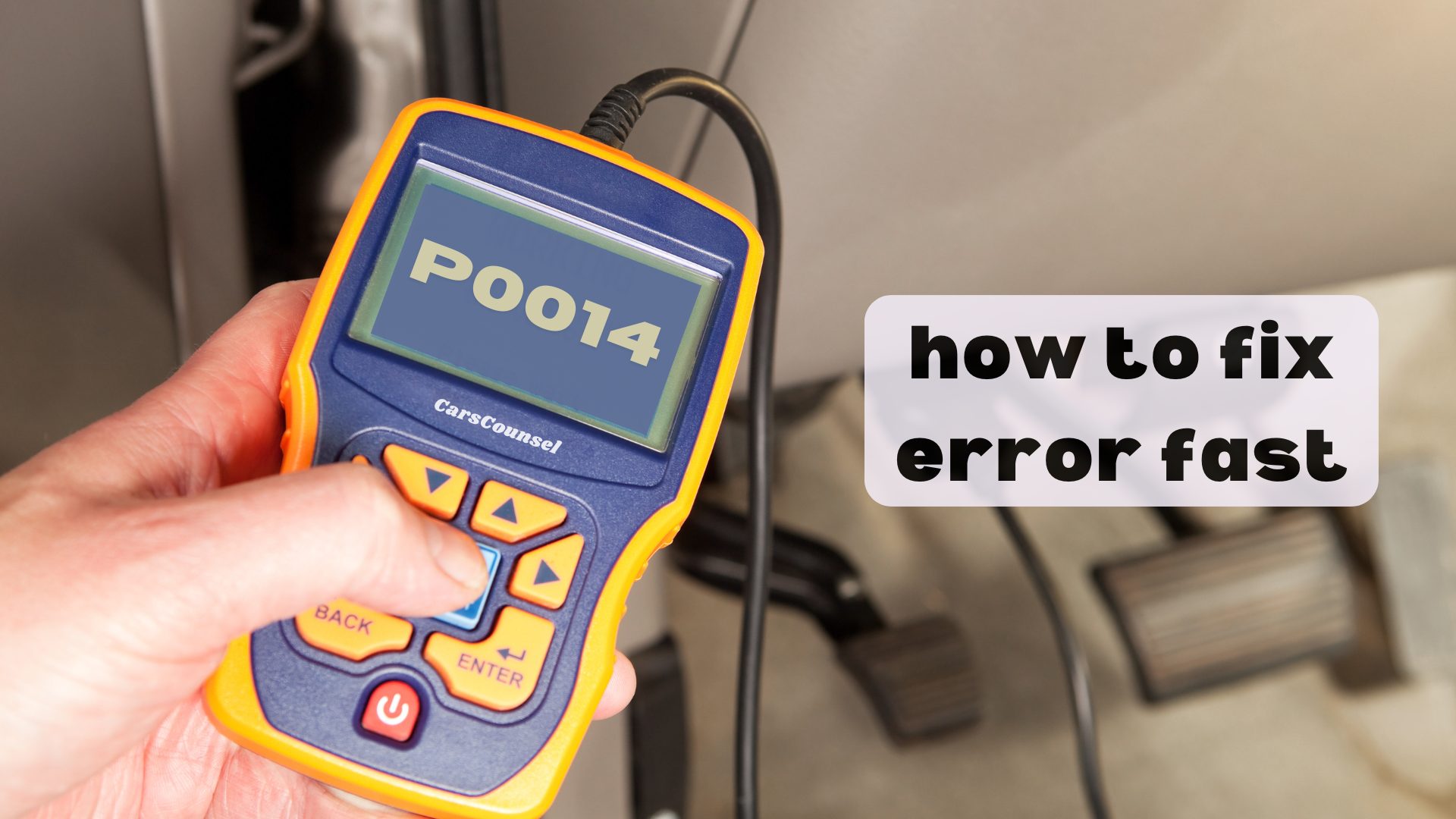You might not know that the P0014 code, which points to a problem with the camshaft position, can often be fixed by simply checking your oil levels.
Low or dirty oil can mess with the engine’s timing, causing this OBD2 Codes error. Before you start stressing about expensive repairs, remember there are some easy steps you can take to solve this problem quickly.
First, check your oil level because it’s a critical factor. After that, you can look at the timing belt or chain if needed.

Quick Navigation
Key Takeaways
- Look at the camshaft position sensor and replace it if it’s broken to get the engine timing back to normal.
- Check the oil levels and add more if needed, making sure you’re using the right kind of oil for good lubrication.
- Check the timing belts or chains for wear or stretching and replace them if needed to fix any misalignment.
- Inspect the camshaft phaser for any damage and replace it if needed to make sure the Variable Valve Timing (VVT) system works properly.
What Is P0014 Code?
The P0014 code is an error code that shows there’s a problem with the timing of the camshaft, specifically that the exhaust camshaft on Bank 1 is too advanced.
When the camshaft timing is off, it messes up the coordination between the camshaft and crankshaft, which can lead to reduced engine power and efficiency.
To fix this, you’ll need to check the camshaft position sensor. This sensor tracks the camshaft’s position and sends this information to the engine control unit (ECU).
If the sensor or its wiring isn’t working right, it can mess up the timing and hurt engine performance.
Catching and fixing this issue early is important to keep your engine running smoothly and efficiently.
Symptoms of P0014 Code
Often, a P0014 code shows up through symptoms like a rough idle, lower gas mileage, and the check engine light turning on.
To find out what’s wrong, use diagnostic tools to spot and fix issues affecting the engine’s performance. Here’s what you might notice:
- Rough Idle: The engine might stutter or shake when your car isn’t moving.
- Lower Gas Mileage: You could see a drop in miles per gallon, meaning the engine isn’t burning fuel efficiently.
- Check Engine Light: This light comes on to warn you that the car’s computer has found a problem that needs quick attention.
If you notice any of these symptoms, it’s important to run diagnostics right away to stop more engine problems.
Using professional tools to identify the issue accurately ensures the repairs are done effectively and on time.
Why P0014 Matters
Understanding why the P0014 code matters can help you see how it prevents major engine damage and keeps your car running well.
This code points to a problem with camshaft timing, which is crucial for your engine’s performance. If the timing is off, it messes up the coordination between the camshaft and crankshaft, causing issues like rough idling and lower fuel efficiency.
Fixing the P0014 code quickly can stop further engine damage and ensure your car runs smoothly. Ignoring this code can lead to serious problems like losing power and hesitation when you accelerate, which can make driving unsafe.
Common Causes of P0014
Several things can trigger the P0014 code, mainly related to sensor problems, oil issues, and timing part failures. Here’s a straightforward breakdown:
- Sensor or Circuit Problems: A bad camshaft position sensor or damaged wiring can mess up the sensor’s readings, causing the P0014 code.
- Oil Issues: Clogged oil passages or low oil pressure can affect how the sensor works, messing with engine timing.
- Timing Part Failures: Worn out or stretched timing belts or chains can make the camshaft turn incorrectly, setting off the code.
Checking Oil Levels
Making sure your car has the right amount of oil is key to keeping your engine running smoothly and avoiding the P0014 error code. Here’s how to do it:
- Check the Dipstick: When the engine is cool, pull out the dipstick to see if the oil level is between the recommended marks.
- Low Oil Levels: If the oil is too low, it can’t lubricate the engine properly, which can mess with the camshaft position sensor.
- Oil Viscosity: Make sure the oil you’re using matches what your car’s manual recommends. Using the wrong type of oil can cause lubrication problems and timing issues.
- Top Off if Needed: Add more oil if the level is low, but also look for any leaks or signs that the oil is old and breaking down.
- Regular Oil Changes: Change the oil regularly to prevent old or dirty oil from clogging the engine’s oil passages, which can lower oil pressure and trigger the P0014 code.
Inspecting Timing Components
Checking the timing components is really important when you’re trying to figure out and fix the P0014 code. This code means there’s an issue with the timing between the crankshaft and camshaft.
Start by looking at the timing belt or chain to see if it’s worn out or damaged. Look for things like fraying or stretching.
Next, check the tensioners and guides to make sure they’re working right.
Finally, make sure the timing marks on the crankshaft and camshaft line up correctly. This will tell you if they’re in sync.
Here’s what to do:
- Look at the Timing Belt/Chain: See if it’s worn or damaged.
- Check Tensioners and Guides: Make sure they’re working properly.
- Align Timing Marks: Confirm the crankshaft and camshaft are synchronized.
Camshaft Phaser Issues
When dealing with the P0014 code, check the camshaft phaser for any damage or wear. This part is crucial for the variable valve timing (VVT) system, as it adjusts the camshaft’s position to improve engine performance.
If the phaser is faulty, it can cause timing problems. Start by looking for any physical damage or signs of wear. A broken camshaft phaser can mess up the variable valve timing, leading to rough idling and poor fuel efficiency.
If you find any damage, replace the camshaft phaser to fix the timing issues. Make sure all connections are secure and the phaser works smoothly.
Fixing camshaft phaser problems quickly can prevent more serious engine issues and keep your vehicle running well.
Replacing Faulty Sensors
Replacing a bad camshaft position sensor involves a few simple steps to get your engine running smoothly again. Here’s how you can do it:
- Take Out the Old Sensor: First, carefully unplug the wiring connector and unscrew the sensor. Make sure to keep any screws or clips you remove.
- Install the New Sensor: Line up the new sensor correctly, screw it in place, and securely reconnect the wiring connector.
- Test the New Sensor: Start the engine to make sure the new sensor fixes the problem and the engine runs smoothly.
Before you start, make sure the new sensor matches your vehicle by checking the part number.
Fixing Wiring Problems
After you replace a bad camshaft position sensor, the next step is to check the wiring to make sure it’s in good shape and connected properly.
Start by looking at the wiring harness to see if there are any signs of wear, fraying, or corrosion. Use a multimeter to check the wiring, making sure there are no breaks in the circuit and that everything is connected.
Make sure all connectors are tightly attached and clean. If you find any damaged wires, fix or replace them to keep the circuit working well.
Good wiring is key for accurate sensor readings and to avoid seeing the P0014 code again. Making sure all connections are solid and all wires are in good condition will help get your engine running at its best.
Preventing P0014 Code
Keeping your car’s oil levels and quality in check is key to avoiding the P0014 code. Good oil maintenance ensures that parts like the camshaft position sensor work properly.
Here are three simple steps to prevent problems:
- Regular Oil Changes: Change the oil and filters often to keep everything well-lubricated and prevent clogs.
- Check the Sensor: Use a multimeter to test the camshaft position sensor now and then to make sure it’s working right.
- Look at Timing Parts: Regularly inspect the timing belt or chain for wear and make sure it’s tight to avoid misalignment.
More OBD-II Codes
Frequently Asked Questions
Can Driving With a P0014 Code Cause Long-Term Engine Damage?
Driving with a P0014 code can cause long-term engine damage. Poor engine performance and bad oil quality can get worse, leading to serious problems like timing issues. Fix the problem quickly to keep your engine in good shape.
How Often Should I Test the Camshaft Position Sensor?
You should check the camshaft and its sensor every 30,000 miles or when you routinely inspect your engine. This helps catch problems early, keeps your engine running well, and avoids bigger issues.
Are There Specific Tools Needed to Diagnose a P0014 Code?
Did you know that 68% of engine problems come from poor maintenance? To diagnose a P0014 code, you’ll need a diagnostic scanner to read the code and tools to check the oil quality. Keeping the oil at the right level and in good condition can help prevent future issues.
What Are the Costs Associated With Fixing a P0014 Code?
Fixing a P0014 code usually costs between $150 and $500, depending on the parts that need replacing, like sensors or timing components. You’ll also need to pay a diagnostic fee, which is typically about $75 to $150. Taking care of the problem quickly can help you avoid even more expensive repairs down the line.
Can a DIY Fix for P0014 Void My Vehicle’s Warranty?
Fixing the P0014 code yourself can cancel your vehicle’s warranty if you don’t follow the manufacturer’s guidelines. Make sure you understand how it can affect your warranty before you start, because doing it wrong could mean they won’t cover future problems related to this issue.
Conclusion
To fix the P0014 code quickly, start by checking your oil levels. Make sure they’re correct.
Also, take a look at your timing belt or chain; they need to be in good shape for your engine to run smoothly.
Replace any bad sensors and repair any damaged wiring.
Regular maintenance is key to keeping this problem from coming back.
By acting now, you can avoid costly repairs in the future.

